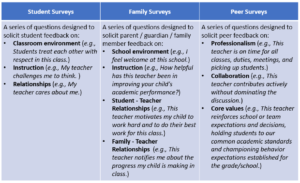Posts Tagged ‘Talent’
Looking Back, Looking Ahead: Lessons learned and what’s to come in 2018-2019
As consultants, our role is to guide our partners to make informed decisions and to successfully meet their goals. We also prioritize building the knowledge and skills of our partners and they tell us that they learn a lot from working alongside us. In turn, we learn so much every day from the incredibly smart and diverse partners we have the good fortune to work with!
As we reflect on the past and look ahead to the new school year, we are grateful for all that we have learned from our clients. In our next couple of blog posts, each Hendy team member will share something he or she has learned and something we’re excited about it. It’s going to be a great year!
To kick us off, read below from our founder, Sarah Rosskamm:
What I learned: Change is hard. Often times the solution is to prepare for change, engage stakeholders, continuously communicate the “why”, work with influencers, plan for challenges and ultimately to just keep going even when it gets tough. There are times, however, when the solution is to pause, reflect and change course. In working with one of our partner charter networks this year, we learned that sometimes the most courageous and best answer is to stop doing something. In this case, our partner was eager to build a teacher career pathway. They took many important steps to get there, had buy-in from leaders and momentum from teachers believing it was valuable. However, they also had budget changes, shifts in capacity and new demands of their attention. As a result, they smartly decided to pause. They stopped putting their attention into the pathway and instead narrowed the scope of their focus to implementing a highly effective evaluation and development structure that would help their teachers to grow and enable them to target their professional learning activities. They focused on laying a foundation that would immediately benefit teachers through continued growth, and will ultimately allow them to move more quickly toward a pathway if and when they choose to pick it up again. It wasn’t easy (for the network or for the Hendy team) to not complete our original shared goal, but it was the right thing to do for their teachers and students.
What I’m excited about: Hendy Avenue’s very first consulting project was supporting the Delaware Department of Education as they considered revisions to their teacher evaluation rubric. After considering several rubric options based on the best of the available rubrics at the time, the Delaware team, similar to the team described above, decided to pause and learn more before making changes to a statewide tool. So, we shifted course and supported four charter schools in Wilmington to design and implement an alternative evaluation system for their teachers that would utilize this new rubric. I worked closely with the leaders in those schools for several years and together we instituted an alternative system that is now used in a growing number of Delaware schools through their Alternative Evaluation system. I am so excited that five years later, after learning a great deal about the use of the current rubric and about the alternative system, Delaware leadership is eagerly partnering with teachers, leaders and other stakeholders to revise the rubric to ensure the tool is well-aligned to new standards and meets the needs of teachers across the state. I’m also thrilled the state has very wisely decided to prioritize involvement of teachers and leaders in the process and to take the time necessary to ensure it’s a positive and welcomed change for their well deserving teachers. And I’m even more excited that Hendy Avenue will be partners in engaging stakeholders, designing, piloting, revising and ultimately building a rubric that helps teachers and leaders be the very best they can be for their students.
Make Your Pick: How the NFL Draft Applies to Teacher Hiring
While there is a lot of best practice research out there about how to hire a great team, leaders seeking teacher talent can take a cue from how professional sports teams scope out and draft players. In the post below, we bring Cade Massey’s article on 5 lessons we can learn from the NFL draft into the world of teacher hiring.
1. Know what you need. Before you even begin to recruit teachers, be clear on what type of teacher you need for your school. Of course, certification, grade and subject-area matches matter, but identifying a great fit requires more. Assess your current staff to identify where your team has strengths, and where there are gaps. Perhaps you need a teacher with great data skills who can support your team’s efforts to review and act on student outcomes. Or perhaps you need a teacher who can effectively implement writing across the curriculum. Also consider your strengths as a leader; do you have capacity to coach a novice teacher? Or do you need someone with more experience? Being clear about the ideal profile of a candidate can help ensure that you focus your limited resources on a hiring process that will yield the best outcome.
2. Get input from others. While the school leader is often the driver and decision-maker when it comes to hiring, ensuring that teachers, other leaders, and even parents are engaged in selection will help ensure that the best candidate is chosen for the school. Consider a process that allows you to solicit input and ideas from a variety of stakeholders. Allow each stakeholder to have an independent review of finalists, and to form their own perspective about fit. One easy way to engage multiple stakeholders quickly is to use a panel interview, or to have multiple stakeholders act as students in a demo lesson (see item 3).
3. Understand the candidate from multiple angles. Resume reviews and interviews are a great first step in getting to know a teacher candidate. But, often that isn’t enough. As football scouts actually see candidates play, getting a glimpse of your top candidates teaching will help you understand how they may fit into your school culture. Request a video of the candidate teaching, or request that they teach a demo lesson in your school or with your selection committee. Even observing 10 minutes of teaching can help you get a full picture of the candidate’s skills and growth areas.
4. Be consistent in your selection model. Hiring is about assessing people, which can be a messy business. No matter how disciplined we are, our opinions of others are naturally informed by the biases we carry; we’re all human after all. As you design your selection approach, consider a rubric and scoring mechanism that makes considering multiple variables factors more formulaic. Bringing order and data to a process like hiring can help ensure that factors like selection bias do not play a significant role in who is selected for your school.
5. Keep score and reevaluate. The only way to know if your selection process worked is to map it against results. Once you’ve selected your dream candidate(s), keep a record of the selection process and the factors that led to their hire. Then, after their first year, compare the teacher’s results to your selection. How accurate was your assessment of their strengths and growth areas? Did your selection approach yield a candidate that made gains with students? If so, what should you replicate? If not, what might you tweak for future hiring?
Sound off in the comments: What lessons have you learned from teacher hiring? What strategies have been most useful in identifying your best candidates?
Keeping the Right People on the Bus
We all know the importance of getting the right people on the bus. But how do we KEEP the right people on the bus?
For all students to thrive, nothing is more important than great teachers and leaders. Yet, we know that recruiting, developing and retaining excellent educators is hard. In eagerness to do better, strategies for teacher and leader retention are often implemented without a thorough examination of the root causes.
To address this challenge, we are now offering an Annual Retention Review to help school system leaders understand why teachers and leaders are leaving and what can be done about it.
We know this work is important, but often falls to the bottom of the to-do list. Through exit surveys and individual interviews of non-returning teachers and leaders, we will develop actionable recommendations to drive your talent strategy. With 25 years of combined experience in developing and leading educator retention solutions, we have the expertise and capacity to help you assess and plan strategies to keep the right people on the bus.
To learn more, email Sarahrosskamm@hendyavenue.com.
Put Excellence at the Heart of Performance Management
Performance management, at its core, sets expectations. It puts a stake in the ground for what “good” looks and sounds like in the classroom and serves as the baseline of teacher observation rubrics. Effective performance management is more than diagnosing current performance; it supports teachers to articulate an actionable, clear trajectory toward excellence. Ultimately, a vision of good teaching and learning must be at the heart of any performance management system.
Common Pitfall: Framework Without Vision
Too often schools and districts launch a performance management system by creating or selecting a rubric without consideration of core instructional priorities. Enthusiasm and urgency, while helpful, can lead to less than ideal system design.
For example, simply adopting an existing framework because it is “proven” or “research-based” might not actually lead schools and teachers to excellence: what might be excellent teaching in one context might not be true in another setting. Creating a framework from scratch in a vacuum, separate from instructional priorities, isn’t likely to lead teachers to excellence either.
This doesn’t mean that adopting an existing framework is the wrong strategy, or that creating something new won’t get leaders and teachers where they need to be. It does mean, though, that this work must be grounded in the core realities of instruction necessary to move kids.
Ground Performance Management in a Vision for Excellent Instruction
Co-design and co-own by instructional leaders. Defining excellence for as complex a role as teaching requires a team of individuals, with different areas of expertise and focus. While very often, the development of teacher evaluation systems lives within talent/human resources, great systems strategically draw in additional stakeholders. For quality operations, a talent leader should drive and own the design and implementation of a performance management framework. At the same time, this work should be a shared priority between leaders of talent, academics and school management functions in a network or district. Instructional leaders working in schools daily must be the core authors and implementers of expectations for teachers.
Measure what matters. If teachers are held to expectations through a framework that aligns with core instructional priorities, schools are more likely to see improvement in the areas that matter most for students. If a solid instructional vision grounds all decision making, then curricular resources, training, and other supports will naturally stem from that vision. As teachers are supported to meet expectations via appropriate the resources, materials, and training, student learning will flourish.
Lead from your vision. Consider the following questions, and strategically engage others to ensure answers reflect the perspectives of a broad range of stakeholders:
- What are our prevailing beliefs within our system about students, and the role teachers play in their success?
- What do the instructional standards require from our students? And then, by extension, from our teachers?
- In classrooms where good teaching and learning is happening, what are teachers doing? What are students doing?
- How does this differ for different students? Different contexts?
- How do we ensure that the performance management system we design reflects our vision of excellent teaching?
- Who will own this work? How will we ensure that leaders from talent and instruction both continue to be involved?
Let us know what you think in the comments below!
-Jessica
Thank You Teachers!
As we look forward to celebrating Thanksgiving with our families this week, the Hendy Avenue team is reflecting on the many blessings for which we are thankful. We are thankful for our family and friends. We are thankful for the opportunity to partner with wonderful organizations doing incredible work for children. We are thankful for clients who have become friends. We are thankful to work with our fabulous Hendy team members who make us think harder and laugh more.
We are also thankful for the many people in our lives who have helped us along the way. Today we give thanks for the teachers who have shaped our lives and highlight just a few of them.
Sarah: My favorite teacher was Mrs. Ayers, my elementary art teacher. She had an energy and passion for her subject that was contagious and I fell hard for creating art. She brought a talent out of me and made me feel truly special. I think the best teachers are able to connect with their students and bring out a curiosity and a confidence that translates to other parts of their lives. Thank you, Mrs. Ayers!
Jess: My favorite teacher was Mr. Hoffman, my high school English teacher. I was a math and science geek in high school, and never really valued literature. I thought that spending all of my time in the analytical world of experiments and functions would get me to my goals. Mr. Hoffman helped me to understand and appreciate the value of balance in academics and in life. We read the great novels in a way that helped me to build my critical thinking skills in a different way. Thank you, Mr. Hoffman!
Grant: I have to give a Thanksgiving shout out to my AP US History teacher, Mr. Corcoran. The one word that comes to mind when I think back to Mr. C’s class is rigor. Not only was the course demanding in terms of workload, but it was a intellectually exhausting and exhilarating experience, every day. You had to show up prepared, engage with your peers, argue your points, and justify your thinking. Nothing less than our best was accepted. Thank you Mr. Corcoran for pushing me to demand excellence of myself and forging how to think, write, and speak with integrity.
Designing Evaluation Frameworks with Development at the Core – Part III: Amplifying Stakeholder Voice with Surveys
This post is the third in a series on how innovators are reimagining the design and implementation of evaluation and development frameworks. Read our earlier posts on observation frequency and raising rubric rigor.
When you think of a teacher, where are they? What are they doing? If you envisioned someone standing in front of a blackboard, lecturing a group of students, you’re likely not alone. In reality however, teachers spend their days in a multitude of ways: working individually with students, collaborating with peers, planning independently, connecting with parents and family members.
Definitions of excellent teaching therefore must go beyond classroom observations and measures of student outcomes (both of which are important!), to gather a broader view of a teacher’s impact.
Surveys are a simple, yet powerful tool that can amplify the voices of stakeholders from across a school community to help educators develop a comprehensive view of excellence.
The Benefits of Administering Surveys
- Surveys, coupled with other measures like classroom observations, provide rich information to help teachers improve their practice. Teaching is a complex job that depends on strong relationships. While districts and schools have made progress in collecting data and providing feedback on certain aspects of the profession (e.g., content knowledge, teaching strategies, assessment data), our field often misses the opportunity to coach teachers on their relationship building with students, families and peers.
- Research says that students are reliable evaluators of a teacher’s impact. Analysis by the Measures of Effective Teaching (MET) project finds that teachers’ student survey results are predictive of student achievement gains. In other words, students know an effective classroom when they experience one.
- Surveys provide the opportunity to put values into practice. Value statements like “we are a team and family” or “parents are partners” are powerful; however, these beliefs are only as true as the actions taken to build an authentic community. Administering surveys of key stakeholders sends a strong message that the voices of community members are valued, respected and heard.
- Surveys provide clear and transparent expectations to teachers. When questions are shared with teachers in advance, the survey content provides clear definitions for expected behaviors in teacher-to-teacher, teacher-to-student, and teacher-to-family relationships. For example, if a survey asks families if they receive one or more positive phone calls a month from their child’s teacher, that sets a very clear expectations for the teacher-family relationship.
Survey Types
Educators have available a number of survey types, structures, question formats and administration platforms.The table below highlights three common survey types.
Surveys should be designed thoughtfully, taking into consideration the purpose, audience, and respondents.
- Purpose – Why are you administering the survey? What do you hope to learn? How will results be utilized?
- Audience – Who will analyze and interpret the survey results? When and how will they reflect on and plan from the results? How will the results be debriefed with teachers to improve practice?
- Respondents – Who will complete the survey? When and how will they complete the survey? What directions, supports and technology will be necessary for administration?

To learn more, including a list of sample survey questions, visit the resources page of our website.
Designing Evaluation Frameworks with Development at the Core – Part II: Raising Rubric Rigor
This post is the second in a series on how innovators are reimagining the design and implementation of evaluation and development frameworks. To read our first post in the series, on the impact of frequent observations, click here.

Most teacher evaluation systems today include direct observations of teacher practice by an administrator, in which the administrator determines ratings by assessing what they observed against a common performance rubric. It is challenging to capture the complexity of teaching in a single document, however strong rubrics have the capacity to set clear expectations, establish a common language, and chart a course for development over time.
During our work with school systems across the country, we have seen a few common challenges with widely-used rubrics:
1. Structure: Rubrics can be too long, wordy, and easy to master.
When rubrics are too lengthy, they can be overwhelming or intimidating to educators, fail to prioritize high-leverage teacher actions over lower-impact strategies, take too long for observers to complete and are challenging to norm across multiple raters. Additionally, when rubrics are too “easy”–that is when basic instruction with minimal impact on student learning aligns to language at the highest levels–we rob educators of a true pathway for growth in their careers and limit their potential for excellence.
2. Framing: Rubrics generally focus only on teachers.
When rubrics describe only what teachers are doing and saying they fail to take into account what matters most: the impact of instruction on students. This can limit the value of observation feedback and lead to misalignment between observation ratings and other components of an evaluation framework.
3. Content: Rubrics are often not aligned to today’s raised academic expectations.
When rubrics do not call for rigorous instruction aligned to core content standards (Common Core, Next Generation Science, etc.) they miss the opportunity to set expectations for learning at the appropriate bar. Similarly, as our knowledge of social-emotional learning, cultural competency, and technology expand, many rubrics have yet to adapt and account for new knowledge and skills.
In the face of these challenges, innovators are creating a new normal for observation rubrics. Through our partnership with school systems across the country, we have seen that there is no one right way or perfect rubric. Rather, systems need to consider their unique culture, expectations, observer skill level and existing structures to find or develop a rubric that will work best for them.
DREAM Charter School: DREAM prioritized finding a streamlined observation rubric that would be appropriately rigorous as teacher advances along their career while less cumbersome than the tool they had previously been using. Following research into available tools and piloting of a select few, DREAM identified the TNTP Core Teaching Rubric as the right resource: it was aligned to academic content standards, written in the form of student outcomes, and best of all, was only four pages long! DREAM revised some language to incorporate school-specific competencies that drive their unique student and adult culture. Following the first year of implementation, nearly 80% of teachers said the rubric defines excellent instruction well.
KIPP Houston Public Schools: The original and largest KIPP region is currently piloting the Reach to Rigor rubric, a new tool created in-house that defines academic and cultural expectations for teachers and students. The rubric is broken down into four parts with only the most critical components of great instruction included. The rubric language also includes both teacher and student actions, to ensure that instructional moves by the teacher are only deemed high-quality if they have the desired effect on student thinking and behavior.
Achievement First: One of the first movers in formalizing a career pathway for teachers, Achievement First has refined their approach to observation and feedback over time. The network developed and launched an updated AF Essentials Rubric that was intentionally designed to be concise, clear, focused on student actions. The rubric is aligned to the Common Core and expectations of Advanced Placement courses, shifting more emphasis to intellectual rigor and deep student thinking. The rubric includes both “foundational” (e.g., tight classroom or kids on task) and excellence (e.g., investment and deep student thinking) criteria.
What are other innovations in observation rubrics? Add your ideas and/or experiences in the comments section below.
Great Leaders, Great Teachers: How Cleveland Metro is Investing in Leaders
In response to Race to the Top, many states, including Ohio, revised state statutes requiring school districts to develop new evaluation models. In a collaborative effort, the Cleveland Metropolitan School District and the Cleveland Teachers’ Union developed the Teacher Development and Evaluation System (TDES).
We partnered with the talent team at CMSD to develop tools and trainings designed to enhance administrators’ ability to successfully evaluate and develop their teachers. We began the engagement with a robust review of existing research and best practices in order to establish a clear description of the knowledge and skills necessary for leading effective observation and feedback.
Following stakeholder review and investment in the new district-wide expectations, we established a theory of action for building administrator capacity across the district, developing an aligned scope and sequence of training modules aimed at achieving CMSD’s goals. Each training module focuses on both observer calibration and quality feedback for improvement, sharing tools and protocols aimed at bridging the learning into the daily practice of administrators.
Taken together, these training modules provided administrators regular opportunities to reflect on and hone their practice as instructional leaders, improving teacher quality and ultimately, the achievement of students across the district.
Welcome to the Hendy Avenue Blog
Welcome to Hendy Avenue Consulting’s new blog!
Over the past four years, we have have been fortunate to partner with wonderful school systems across the country to help them grow and retain talent. And we’ve learned a lot! We are excited to launch this site as an opportunity to share what we’re learning, disseminate research, highlight best practices, present case studies of promising practices and post interviews with leaders in the field.
In the coming weeks, we will publish posts on how school systems can put teacher development at the core of evaluations, a case study of how KIPP Austin is investing in teachers, and a run-down of some of the recent research we have been reading.
We hope you enjoy each post, leave comments, and share with those in your network.
At Hendy Avenue Consulting, we believe that investing in talent has the potential to dramatically change the landscape of education in our country and the lives of millions of children. You can learn more about us and our work here.







